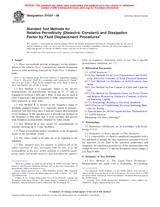Potřebujeme váš souhlas k využití jednotlivých dat, aby se vám mimo jiné mohly ukazovat informace týkající se vašich zájmů. Souhlas udělíte kliknutím na tlačítko „OK“.
ASTM D1531-06
Standard Test Methods for Relative Permittivity (Dielectric Constant) and Dissipation Factor by Fluid Displacement Procedures (Withdrawn 2012)
Automaticky přeložený název:
Standardní zkušební metody pro relativní permitivita (permitivita ) a Ztrátový činitel podle tekutin postupů (Withdrawn 2012 )
NORMA vydána dne 1.10.2006
Informace o normě:
Označení normy: ASTM D1531-06
Poznámka: NEPLATNÁ
Datum vydání normy: 1.10.2006
Kód zboží: NS-17577
Počet stran: 11
Přibližná hmotnost: 33 g (0.07 liber)
Země: Americká technická norma
Kategorie: Technické normy ASTM
Anotace textu normy ASTM D1531-06 :
Keywords:
dielectric constant, dissipation factor, fluid displacement (single fluid), fluid displacement (two fluid), immersion method, permittivity, ICS Number Code 83.080.20 (Thermoplastic materials)
Doplňující informace
| Significance and Use | ||||||||||||||||
|
Permittivity: 5.1.1 Polyethylene and Materials of Permittivity Within 0.1 of That of Polyethylene—Since the permittivity of benzene or 1-cSt silicone fluid is very close to that of polyethylene, these fluids are recommended for highly accurate and precise testing of polyethylene or other materials with permittivity close to that of polyethylene. These aspects of the test method make it a suitable tool to determine batch-to-batch uniformity of a polyethylene compound to meet precise requirements of high capacitance uniformity and capacitance stability in electronic apparatus. It also serves as a means to detect impurities, as well as changes resulting from prolonged exposure to high humidity, water immersion, weathering, aging, processing treatments, and exposure to radiation. 5.1.2 Other Materials—This test method provides advantages for routine testing of those materials that have a poorer match in permittivity between the liquids mentioned in 5.1.1 and the specimen. These advantages include, but are not limited to, a reduction of the probability of errors caused by imprecise thickness data and the ease with which tests can be performed. Correction factors can be calculated to account for the bias introduced by the permittivity mismatch. The two liquids mentioned in 5.1.1 are not the only liquids having known values of dielectric properties and are known to be compatible with a solid electrical insulating material. Dissipation Factor—Normally, polyethylene has a very low dissipation factor, and a test specimen exhibiting an abnormally high dissipation factor would be suspected of containing impurities or being contaminated. The reproducibility of dissipation factor by this test method is somewhat better than that obtainable with the more conventional methods, but is limited by the sensitivity of commercially available measuring apparatus. |
||||||||||||||||
| 1. Scope | ||||||||||||||||
|
1.1 These test methods provide techniques for the determination of the relative (Note 1) permittivity and the dissipation factor of solid insulating materials by fluid (Note 2) displacement. Note 1—In common usage, the word "relative" is frequently dropped. Note 2—The word "fluid" is a commonly used synonym for "liquid" and yet a gas is also a fluid. In this standard, the word "fluid" is used to show that liquid is not all that is meant. 1.2 Test Method A is especially suited to the precise measurements on polyethylene sheeting at 23°C and at frequencies between 1 kHz and 1 MHz. It may also be used at other frequencies and temperatures to make measurements on other materials in sheet form. 1.3 Test Method B is limited to the frequency range of available guarded bridges. It is especially suited to measurements on very thin films since it does not require determination of the thickness of the specimen yet it provides an estimate of the thickness of thin films that is more accurate and precise than thickness measurements obtained by other means. 1.4 Test Method B is also useful for measurements of polymer sheeting up to 2-mm thickness. 1.5 These test methods permit calculation of the dissipation factor of the specimens tested. 1.6 The values stated in SI units are to be regarded as the standard. 1.7 This standard does not purport to address all of the safety concerns, if any, associated with its use. It is the responsibility of the user of this standard to establish appropriate safety and health practices and determine the applicability of regulatory limitations prior to use. For a specific precautionary statement, see 7.2. |
||||||||||||||||
| 2. Referenced Documents | ||||||||||||||||
|
Odebírejte informace o nově vydaných normách ZDARMA:
Chcete pravidelně odebírat informace o nově vycházejících normách z celého světa a to zcela zdarma?
Přihlašte se k odběru. Vše je velice jednoduché a absolutně ZDARMA.
Na výběr máte vydavatele z celého světa.




 Cookies
Cookies
